|
IES
Purchasing: Supplier Dispatch Note Import
Purpose
The purpose of this Document
is to explain how Goods Received can be automatically processed by
importing a Supplier Dispatch Note, and how this facilitates Landed
Cost Processing as well.
Introduction
A Supplier Dispatch Note is
a document that lists the Items shipped in the current dispatch, i.e.
which becomes a receipt of Ordered Goods, and in the case of importing
possibly includes 1 or more ‘shipped’ containers, or a shared part
of a shipped container. Supplier Dispatch Notes can include multiple
Purchase Orders without necessarily including all the Order Items on
those PO’s. By having a ‘dispatch import’ facility, it is much
easier to process the Goods Received, because the system can do it
automatically instead of each Order Item having to be processed by an
Operator, by Purchase Order. In addition, the system is able to flag
all the included Order Items as a ‘basket’ which may easily be
retrieved for Landed Cost Processing, i.e. the Items will be correctly
listed on a weighted basis for Landed Cost processing, with no effort
at all.
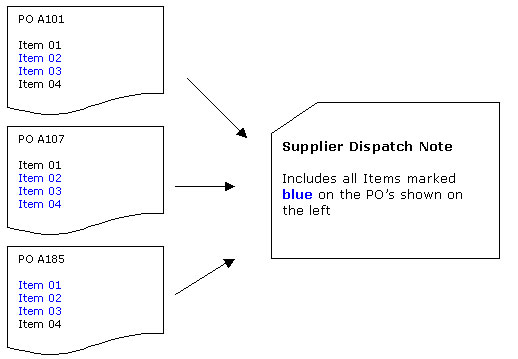
In the illustration above,
which includes only a few Items, it is clear that if the Dispatch Note
includes only SOME Items from a range of Purchase Orders (which may
possibly run into hundreds of Items), it could be a major task for an
Operator (User) to process each received Item correctly, by Purchase
Order. And when it is time to perform Landed Costs on weighted basis,
all the Purchase Orders would have to be listed, which will then
include all Order Items on those Purchase Orders, and one would have
to ‘weed out’ the unwanted Items before performing the Landed
Costs.
However, by using the
Dispatch Note Import, the system will automatically process all the
GRV’s (Goods Received Voucher processing), and at the same time flag
the ‘basket’ of Items as a group for possible Landed Cost
processing. (Hint: The Landed Cost option for ‘basket’ processing
is discussed in the Landed Costs User Manual).
Importing
and Processing a Dispatch Note

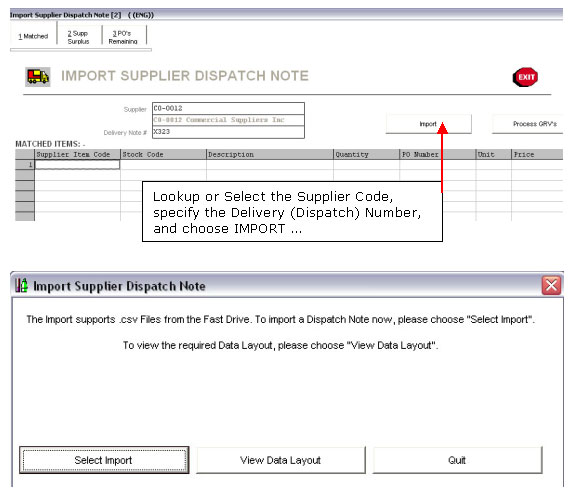
The required Data Layout is
very simple, and can easily be formatted from a supplied Spread Sheet
from the Supplier, and saved as .CSV before importing. If no such
Spread Sheet is available from the Supplier, then it is a simple task
to prepare it. The system offers the following when ‘View Data
Layout’ is selected.
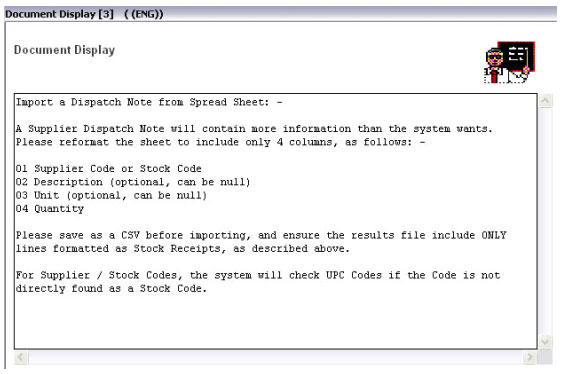
Once you select the file to
import, the system will scan it’s contents, and scan all Order Items
for the current Supplier on any Open Orders, i.e. Items that have not
been received yet.
The Import screen has 3
tabs: -
Matched Items
Includes
all Items where the system matches an Order Item Quantity on the
Dispatch Note with an Order Item Quantity not yet received (and the
system
will automatically match Supplier Codes with Stock Codes if the
UPC’s are specified on the Stock Code Master) ;
Supplier Surplus
Includes any Items that are
present on the Dispatch Note but are not on order, or cannot be matched to a Stock
Item ;
PO’s Remaining
Includes all other Items for
this Supplier that are still ‘on order’ and not in the current dispatch ;
If indeed any items are
present on the ‘Supplier Surplus’ tab, then it is a good idea to
abandon the processing at this stage, specify the necessary UPC’s
for matching, flag the unwanted Items for Return, OR process a new
Proforma Order for excess Items that you wish to retain (and have the
Proforma approved so the Items can be listed as ‘on order’ and
therefore matched if the Dispatch Import is attempted again.
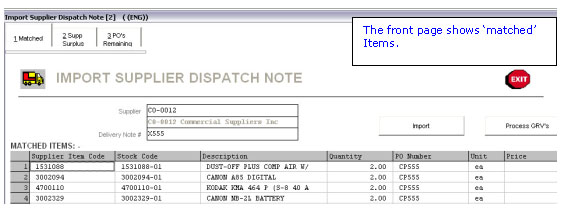

When all Items are correctly
matched, just choose “PROCESS GRV’S” for the system to
automatically process the Items as received.
It is possible that during
this step (auto processing) some errors may occur. For example, if a
Purchase Order that should be processed is found ‘locked by another
User’, it will not be processed, but the system will report the
fact. In such case, the Dispatch can be imported again afterwards, and
processed again. BUT the dispatch note file should be edited 1st,
to include ONLY the Items that could not be processed. If not, some
Items may be incorrectly processed in the next attempt. For example,
if Item XXX were on order for a quantity of 10, and the dispatch
includes 5, then the 5 will be matched and processed in the 1st
attempt. If the same 5 is present on the 2nd import, they
will be processed again because there are still 5 on order, but this
is wrong because that would add up to 10 being received instead of 5
only that were included in the dispatch.
Note: If the same Dispatch
is processed more than once, i.e. in parts, the parts can still be
‘collectively’ selected for Landed Cost processing (see the Landed
Costs User Manual).
Query
a prior Dispatch Note
Once a Dispatch Note has
been processed by choosing “PROCESS GRV’S”, this is final, and
irreversible. Any corrections to this can only be done 1 by 1 by
processing a Purchase Order itself.
A Dispatch Note that has
been processed can be queried, and will only show Items that are fully
processed. In other words, any Item that originally showed as a
‘match’ but could be some reason not be processed will be dropped
and will not be listed on the processed Dispatch Note.
From the main Purchasing
options, choose Query, then choose ‘Supplier Dispatch Note
(Imported)’.
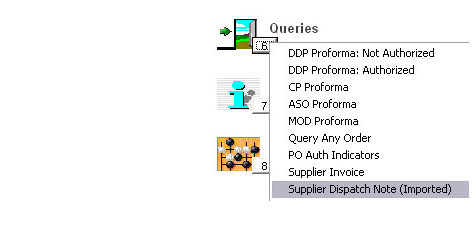
©
Infolab, 2006
|